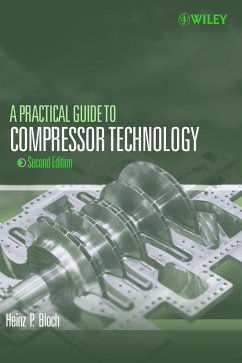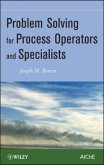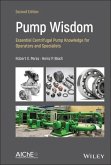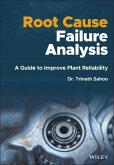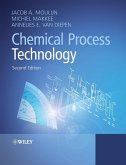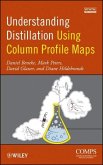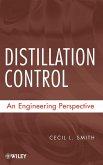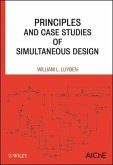Heinz P. Bloch
Guide Compressor Tech 2e
Heinz P. Bloch
Guide Compressor Tech 2e
- Gebundenes Buch
- Merkliste
- Auf die Merkliste
- Bewerten Bewerten
- Teilen
- Produkt teilen
- Produkterinnerung
- Produkterinnerung
A Complete overview of theory, selection, design, operation, and maintenance This text offers a thorough overview of the operating characteristics, efficiencies, design features, troubleshooting, and maintenance of dynamic and positive displacement process gas compressors. The author examines a wide spectrum of compressors used in heavy process industries, with an emphasis on improving reliability and avoiding failure. Readers learn both the theory underlying compressors as well as the myriad day-to-day practical issues and challenges that chemical engineers and plant operation personnel must…mehr
Andere Kunden interessierten sich auch für
![Problem Solving for Process Operators and Specialists Problem Solving for Process Operators and Specialists]() J. M. BonemProblem Solving for Process Operators and Specialists101,99 €
J. M. BonemProblem Solving for Process Operators and Specialists101,99 €![Pump Wisdom Pump Wisdom]() Robert X. PerezPump Wisdom90,99 €
Robert X. PerezPump Wisdom90,99 €![Root Cause Failure Analysis Root Cause Failure Analysis]() Trinath SahooRoot Cause Failure Analysis145,99 €
Trinath SahooRoot Cause Failure Analysis145,99 €![Chemical Process Technology Chemical Process Technology]() Jacob A. MoulijnChemical Process Technology55,99 €
Jacob A. MoulijnChemical Process Technology55,99 €![Understanding Distillation Using Column Profile Maps Understanding Distillation Using Column Profile Maps]() Daniel BenekeUnderstanding Distillation Using Column Profile Maps170,99 €
Daniel BenekeUnderstanding Distillation Using Column Profile Maps170,99 €![Distillation Control Distillation Control]() Cecil L. SmithDistillation Control102,99 €
Cecil L. SmithDistillation Control102,99 €![Principles and Case Studies of Simultaneous Design Principles and Case Studies of Simultaneous Design]() William L. LuybenPrinciples and Case Studies of Simultaneous Design176,99 €
William L. LuybenPrinciples and Case Studies of Simultaneous Design176,99 €-
-
-
A Complete overview of theory, selection, design, operation, and maintenance
This text offers a thorough overview of the operating characteristics, efficiencies, design features, troubleshooting, and maintenance of dynamic and positive displacement process gas compressors. The author examines a wide spectrum of compressors used in heavy process industries, with an emphasis on improving reliability and avoiding failure. Readers learn both the theory underlying compressors as well as the myriad day-to-day practical issues and challenges that chemical engineers and plant operation personnel must address.
The text features:
Latest design and manufacturing details of dynamic and positive displacement process gas compressors
Examination of the full range of machines available for the heavy process industries
Thorough presentation of the arrangements, material composition, and basic laws governing the design of all important process gas compressors
Guidance on selecting optimum compressor configurations, controls, components, and auxiliaries to maximize reliability
Monitoring and performance analysis for optimal machinery condition
Systematic methods to avoid failure through the application of field-tested reliability enhancement concepts
Fluid instability and externally pressurized bearings
Reliability-driven asset management strategies for compressors
Upstream separator and filter issues
The text s structure is carefully designed to build knowledge and skills by starting with key principles and then moving to more advanced material. Hundreds of photos depicting various types of compressors, components, and processes are provided throughout.
Compressors often represent a multi-million dollar investment for such applications as petrochemical processing and refining, refrigeration, pipeline transport, and turbochargers and superchargers for internal combustion engines. This text enables the broad range of engineers and plant managers who work with these compressors to make the most of the investment by leading them to the best decisions for selecting, operating, upgrading, maintaining, and troubleshooting.
This text offers a thorough overview of the operating characteristics, efficiencies, design features, troubleshooting, and maintenance of dynamic and positive displacement process gas compressors. The author examines a wide spectrum of compressors used in heavy process industries, with an emphasis on improving reliability and avoiding failure. Readers learn both the theory underlying compressors as well as the myriad day-to-day practical issues and challenges that chemical engineers and plant operation personnel must address.
The text features:
Latest design and manufacturing details of dynamic and positive displacement process gas compressors
Examination of the full range of machines available for the heavy process industries
Thorough presentation of the arrangements, material composition, and basic laws governing the design of all important process gas compressors
Guidance on selecting optimum compressor configurations, controls, components, and auxiliaries to maximize reliability
Monitoring and performance analysis for optimal machinery condition
Systematic methods to avoid failure through the application of field-tested reliability enhancement concepts
Fluid instability and externally pressurized bearings
Reliability-driven asset management strategies for compressors
Upstream separator and filter issues
The text s structure is carefully designed to build knowledge and skills by starting with key principles and then moving to more advanced material. Hundreds of photos depicting various types of compressors, components, and processes are provided throughout.
Compressors often represent a multi-million dollar investment for such applications as petrochemical processing and refining, refrigeration, pipeline transport, and turbochargers and superchargers for internal combustion engines. This text enables the broad range of engineers and plant managers who work with these compressors to make the most of the investment by leading them to the best decisions for selecting, operating, upgrading, maintaining, and troubleshooting.
Produktdetails
- Produktdetails
- Verlag: Wiley & Sons
- Artikelnr. des Verlages: 14672793000
- 2. Aufl.
- Seitenzahl: 590
- Erscheinungstermin: 1. September 2006
- Englisch
- Abmessung: 260mm x 183mm x 36mm
- Gewicht: 1129g
- ISBN-13: 9780471727934
- ISBN-10: 0471727938
- Artikelnr.: 22019081
- Herstellerkennzeichnung
- Libri GmbH
- Europaallee 1
- 36244 Bad Hersfeld
- gpsr@libri.de
- Verlag: Wiley & Sons
- Artikelnr. des Verlages: 14672793000
- 2. Aufl.
- Seitenzahl: 590
- Erscheinungstermin: 1. September 2006
- Englisch
- Abmessung: 260mm x 183mm x 36mm
- Gewicht: 1129g
- ISBN-13: 9780471727934
- ISBN-10: 0471727938
- Artikelnr.: 22019081
- Herstellerkennzeichnung
- Libri GmbH
- Europaallee 1
- 36244 Bad Hersfeld
- gpsr@libri.de
HEINZ P. BLOCH, MS, is a Consulting Engineer. Previously, Mr. Bloch held the position of regional machinery specialist for the United States at Exxon Chemical. He has authored seventeen books and more than 330 papers and articles and conducted more than 500 technical courses on such issues as practical machinery management, failure analysis and avoidance, turbomachinery, oil mist lubrication, and practical lubrication for industrial facilities.
PREFACE xiii
ACKNOWLEDGMENTS xv
PART I POSITIVE DISPLACEMENT COMPRESSOR TECHNOLOGY 1
1 Theory 3
1.1 Symbols 3
1.2 How a Compressor Works 4
1.3 First Law of Thermodynamics 8
1.4 Second Law of Thermodynamics 8
1.5 Ideal or Perfect Gas Laws 9
1.5.1 Boyle's Law 9
1.5.2 Charles' Law 9
1.5.3 Amonton's Law 9
1.5.4 Dalton's Law 9
1.5.5 Amagat's Law 10
1.5.6 Avogadro's Law 10
1.5.7 Perfect Gas Formula 10
1.6 Vapor Pressure 11
1.7 Gas and Vapor 11
1.8 Partial Pressures 11
1.9 Critical Conditions 13
1.10 Compressibility 13
1.11 Generalized Compressibility Charts 14
1.12 Gas Mixtures 15
1.13 The Mole 15
1.14 Specific Volume and Density 16
1.15 Volume Percent of Constituents 16
1.16 Molecular Weight of a Mixture 16
1.17 Specific Gravity and Partial Pressure 17
1.18 Ratio of Specific Heats 17
1.19 Pseudo-critical Conditions and Compressibility 18
1.20 Weight-Basis Items 18
1.21 Compression Cycles 19
1.22 Power Requirement 20
1.23 Compressibility Correction 21
1.24 Multiple Staging 22
1.25 Volume References 23
1.26 Cylinder Clearance and Volumetric Efficiency 24
1.27 Cylinder Clearance and Compression Efficiency 27
Reference 27
2 Reciprocating Process Compressor Design Overview 29
2.1 Crankshaft Design 33
2.2 Bearings and Lubrication Systems 37
2.3 Connecting Rods 37
2.4 Crossheads 38
2.5 Frames and Cylinders 39
2.6 Cooling Provisions 45
2.7 Pistons 47
2.8 Piston and Rider Rings 47
2.9 Valves 48
2.10 Piston Rods 51
2.11 Packings 55
2.12 Cylinder Lubrication 55
2.13 Distance Pieces 56
2.14 Reciprocating Compressor Modernization 57
2.14.1 Cylinder Upgrades 59
2.14.2 Design for Easy Maintenance 59
2.14.3 Crosshead Designs and Attention to Reliable Lubrication 61
2.14.4 Materials 62
3 Reciprocating Compressor Performance and Monitoring Considerations 63
3.1 Capacity Control 63
3.1.1 Recycle or Bypass 64
3.1.2 Suction Throttling 64
3.1.3 Suction Valve Unloading 65
3.1.4 Clearance Pockets 67
3.2 More About Cylinder Jacket Cooling and Heating Arrangements 70
3.2.1 Methods of Cooling 71
3.3 Comparing Lubricated and Nonlubricated Conventional Cylinder
Construction 73
3.3.1 Lubricated Cylinder Designs 73
3.3.2 Nonlubricated Cylinder Design 75
3.4 Compressor Vent and Buffer Systems 76
3.5 Compressor Instrumentation 77
3.5.1 Electric vs. Pneumatic Switches 82
3.5.2 Switch Set Points 82
3.5.3 Control Panels 82
3.5.4 Valve-in-Piston Reciprocating Compressors 83
3.5.5 Barrel-Frame Reciprocating Compressors 84
3.6 Condition Monitoring of Reciprocating Compressors 85
3.6.1 Maintenance Strategies 86
3.6.2 Justification for Machine Monitoring 86
3.6.3 What to Monitor and Why 87
References 97
4 Labyrinth Piston Compressors 99
4.1 Main Design Features 99
4.2 Energy Consumption 101
4.3 Sealing Problems 104
5 Hypercompressors 109
5.1 Introduction 109
5.2 Cylinders and Piston Seals 111
5.3 Cylinder Heads and Valves 115
5.4 Drive Mechanism 117
5.5 Miscellaneous Problems 119
5.6 Conclusions 120
6 Metal Diaphragm Compressors 121
6.1 Introduction 121
6.2 Terminology 121
6.3 Description 122
7 Lobe and Sliding Vane Compressors 129
8 Liquid Ring Compressors 135
9 Rotary Screw Compressors and Filter Separators 141
9.1 Twin-Screw Machines 141
9.1.1 Working Phases 141
9.1.2 Areas of Application 145
9.1.3 Dry vs. Liquid-Injected Machines 145
9.1.4 Operating Principles 145
9.1.5 Flow Calculation 147
9.1.6 Power Calculation 147
9.1.7 Temperature Rise 150
9.1.8 Capacity Control 150
9.1.9 Mechanical Construction 153
9.1.10 Industry Experience 154
9.1.11 Maintenance History 158
9.1.12 Performance Summary 158
9.2 Oil-Flooded Single-Screw Compressors 160
9.3 Selecting Modern Reverse-Flow Filter-Separator Technology 163
9.3.1 Conventional Filter-Separators vs. SCCs 164
9.3.2 Removal Efficiencies 165
9.3.3 Filter Quality 165
9.3.4 Selecting the Most Suitable Gas Filtration Equipment 166
9.3.5 Evaluating the Proposed Configurations 167
9.3.6 Life-Cycle-Cost Calculations 168
9.3.7 Conclusions 169
10 Reciprocating Compressor Performance and Sizing Fundamentals 171
10.1 Theoretical Maximum Capacity 172
10.2 Capacity Losses 173
10.3 Valve Preload 174
10.4 Valve and Gas Passage Throttling 174
10.5 Piston Ring Leakage 176
10.6 Packing Leakage 177
10.7 Discharge Valve Leakage 177
10.8 Suction Valve Leakage 178
10.9 Heating Effects 178
10.10 Pulsation Effects 180
10.11 Horsepower 181
10.12 Horsepower Adders 181
10.13 Gas Properties 182
10.13.1 Ideal Gas 182
10.13.2 Real Gas 182
10.14 Alternative Equations of State 183
10.15 Condensation 183
10.16 Frame Loads 183
10.17 Compressor Displacement and Clearance 184
10.18 Staging 186
10.19 Fundamentals of Sizing 187
10.19.1 Number of Stages 187
10.19.2 Approximate Horsepower 187
10.19.3 Cylinder Bore Requirements 188
10.19.4 Frame Load 188
10.19.5 Vendor Confirmation 189
10.20 Sizing Examples 189
PART II DYNAMIC COMPRESSOR TECHNOLOGY 197
11 Simplified Equations for Determining the Performance of Dynamic
Compressors 205
11.1 Nonoverloading Characteristics of Centrifugal Compressors 205
11.2 Stability 205
11.3 Speed Change 207
11.4 Compressor Drive 207
11.5 Calculations 208
12 Design Considerations and Manufacturing Techniques 215
12.1 Axially vs. Radially Split 215
12.2 Tightness 215
12.3 Material Stress 215
12.4 Nozzle Location and Maintenance 216
12.5 Design Overview 217
12.5.1 Casings 217
12.5.2 Flow Path 230
12.5.3 Rotors 234
12.5.4 Impellers 234
12.5.5 Axial Blading 242
12.5.6 Seals 242
12.6 Bearing Configurations 250
12.6.1 Radial Bearings 250
12.6.2 Thrust Bearings 251
12.6.3 Flexure Pivot Tilt Pad Bearings 253
12.7 Casing Design Criteria 257
12.8 Casing Manufacturing Techniques 265
12.9 Stage Design Considerations 273
12.10 Impeller Manufacturing Techniques 282
12.11 Rotor Dynamic Considerations 286
12.12 Fouling Considerations and Coatings 292
12.12.1 Polymerization and Fouling 292
12.12.2 Fouling and Its Effect on Compressor Operation 293
12.12.3 Coating Case Study 294
12.12.4 SermaLon Coating 296
12.12.5 Results 297
13 Advanced Sealing and Bearing Systems 299
13.1 Background 299
13.2 Dry Seals 300
13.2.1 Operating Principles 300
13.2.2 Operating Experience 302
13.2.3 Problems and Solutions 303
13.2.4 Dry Seal Upgrade Developments 304
13.2.5 Dry Gas Seal Failures Avoided by Gas Conditioning 304
13.3 Magnetic Bearings 308
13.3.1 Operating Principles 308
13.3.2 Operating Experience and Benefits 310
13.3.3 Problems and Solutions 311
13.4 Development Efforts 311
13.4.1 Thrust-Reducing Seals 312
13.5 Integrated Designs 314
13.6 Fluid-Induced Instability and Externally Pressurized Bearings 318
13.6.1 Instability Considerations 318
13.6.2 Fluid-Induced Instability 318
13.6.3 Eccentricity and Stiffness 320
13.6.4 Externally Pressurized Bearings and Seals 321
13.6.5 Practical Applications 324
13.6.6 Rotor Model, Dynamic Stiffness, and Fluid Instability 325
13.6.7 Root Locus Stability Analysis 327
13.6.8 More About Externally Pressurized Bearings 328
13.6.9 Field Data Collection 331
13.6.10 Test Stand Data 334
13.6.11 Conclusions 336
References 336
Suggested Reading 336
14 Couplings, Torque Transmission, and Torque Sensing 339
14.1 Coupling Overview 339
14.1.1 Low Overhung Moment 341
14.1.2 Low Residual Unbalance Desired 343
14.1.3 Long Life and Maintainability 344
14.1.4 Continuous Lubrication Not a Cure-All 345
14.1.5 Contoured Diaphragm Coupling 345
14.2 Coupling Retrofits and Upgrades 347
14.3 Performance Optimization Through Torque Monitoring 349
15 Lubrication, Sealing, and Control Oil Systems for Turbomachinery 357
15.1 Considerations Common to All Systems 357
15.2 Seal Oil Considerations 359
16 Compressor Control 363
16.1 Introduction 363
16.2 Control System Objectives 363
16.3 Compressor Maps 364
16.3.1 Invariant Coordinates 366
16.4 Performance Control 368
16.4.1 PI and PID Control Algorithms 370
16.4.2 Stability Considerations 372
16.4.3 Integral or Reset Windup 373
16.5 Performance Limitations 373
16.5.1 Surge Limit 374
16.5.2 Stonewall 375
16.6 Preventing Surge 376
16.6.1 Antisurge Control Variables 376
16.6.2 Antisurge Control Algorithms 378
16.6.3 Controlling Limiting Variables 378
16.7 Loop Decoupling 379
16.8 Conclusions 380
Reference 380
17 Head-Flow Curve Shape of Centrifugal Compressors 381
17.1 Compressor Stage 381
17.2 Elements of the Characteristic Shape 382
17.2.1 Basic Slope 382
17.2.2 Blade Angle 384
17.2.3 Fan Law Effect 385
17.2.4 Choke Effect 386
17.2.5 Mach Number 387
17.2.6 Significance of Gas Weight 387
17.2.7 Inducer Impeller Effects on Head Output 388
17.2.8 Surge 389
17.2.9 Vaned Diffusers 390
17.2.10 Vaneless Diffusers 390
17.2.11 Equivalent Tip Speeds 391
17.3 Conclusions 393
18 Use of Multiple-Inlet Compressors 395
18.1 Critical Selection Criteria 395
18.1.1 Head Rise to Surge, Surge Margin, and Overload Margin 396
18.1.2 Head per Section 397
18.1.3 Compressor Parasitic Flows 398
18.1.4 Excess Margins on Other Process Equipment 399
18.1.5 Representing Compressor Performance 399
18.1.6 Practical Levels of Critical Operating Parameters 399
18.2 Design of a Sideload Compressor 401
18.2.1 Mixing Area 402
18.2.2 Aerodynamics 403
18.2.3 Temperature Stratification 405
18.3 Testing 405
18.3.1 Test Setup 406
18.3.2 Instrumentation 406
18.3.3 Testing Procedure 406
18.3.4 Accuracy of Test Results 407
18.3.5 Evaluation of Results 407
19 Compressor Performance Testing 409
19.1 Performance Testing of New Compressors 409
19.1.1 Re-rate Options 410
19.1.2 General Guidelines 410
19.1.3 Gas Sampling 411
19.1.4 Instrumentation 412
19.1.5 Sideload Compressors 414
19.1.6 Calculation Procedures 416
19.2 Shop Testing and Types of Tests 418
19.3 Field Testing 420
19.4 Predicting Compressor Performance at Other Than As-Designed Conditions
432
19.4.1 How Performance Tests Are Documented 434
19.4.2 Design Parameters: What Affects Performance 434
19.4.3 What to Seek from Vendors' Documents 435
19.4.4 Illustrations and Example 436
References 441
20 Procurement, Audit, and Asset Management Decisions 443
20.1 Incentives to Buy from Knowledgeable and Cooperative Compressor
Vendors 443
20.2 Industry Standards and Their Purpose 444
20.2.1 Typical Scope of Standards 444
20.2.2 Disclaimers in Standards 447
20.2.3 Going Beyond the Standards 447
20.3 Disadvantages of Cheap Process Compressors 448
20.4 Audits vs. Reviews 449
20.4.1 Staffing and Timing of Audits and Reviews 450
20.4.2 Use of Equipment Downtime Statistics 450
20.5 Auditing and Reviewing Compressors 451
20.6 Compressor Inspection: Extension of the Audit Effort 465
20.6.1 Inspection of a Welded Impeller (Wheel) and the Entire Rotor 466
20.7 Compressor Installation Specifications 474
20.7.1 Field Erection and Installation Specifications for Special-Purpose
Machinery 475
References 476
21 Reliability-Driven Asset Management Strategies 477
21.1 Strategy for Reciprocating Compressors 477
21.1.1 Process Operating Window 478
21.1.2 Breakdown Maintenance 478
21.1.3 Time-Based Maintenance 478
21.1.4 Equipment Health Monitoring 479
21.1.5 Reliability and Maintenance 479
21.1.6 Asset Management Strategy 479
21.2 Achieving Compressor Asset Optimization 486
21.2.1 Input Obtained from Workshops 486
21.2.2 Conclusions 496
References 497
APPENDIX A PROPERTIES OF COMMON GASES 499
APPENDIX B SHORTCUT CALCULATIONS AND GRAPHICAL 507
COMPRESSOR SELECTION PROCEDURES
APPENDIX C BIBLIOGRAPHY AND LIST OF CONTRIBUTORS 551
INDEX 557
ACKNOWLEDGMENTS xv
PART I POSITIVE DISPLACEMENT COMPRESSOR TECHNOLOGY 1
1 Theory 3
1.1 Symbols 3
1.2 How a Compressor Works 4
1.3 First Law of Thermodynamics 8
1.4 Second Law of Thermodynamics 8
1.5 Ideal or Perfect Gas Laws 9
1.5.1 Boyle's Law 9
1.5.2 Charles' Law 9
1.5.3 Amonton's Law 9
1.5.4 Dalton's Law 9
1.5.5 Amagat's Law 10
1.5.6 Avogadro's Law 10
1.5.7 Perfect Gas Formula 10
1.6 Vapor Pressure 11
1.7 Gas and Vapor 11
1.8 Partial Pressures 11
1.9 Critical Conditions 13
1.10 Compressibility 13
1.11 Generalized Compressibility Charts 14
1.12 Gas Mixtures 15
1.13 The Mole 15
1.14 Specific Volume and Density 16
1.15 Volume Percent of Constituents 16
1.16 Molecular Weight of a Mixture 16
1.17 Specific Gravity and Partial Pressure 17
1.18 Ratio of Specific Heats 17
1.19 Pseudo-critical Conditions and Compressibility 18
1.20 Weight-Basis Items 18
1.21 Compression Cycles 19
1.22 Power Requirement 20
1.23 Compressibility Correction 21
1.24 Multiple Staging 22
1.25 Volume References 23
1.26 Cylinder Clearance and Volumetric Efficiency 24
1.27 Cylinder Clearance and Compression Efficiency 27
Reference 27
2 Reciprocating Process Compressor Design Overview 29
2.1 Crankshaft Design 33
2.2 Bearings and Lubrication Systems 37
2.3 Connecting Rods 37
2.4 Crossheads 38
2.5 Frames and Cylinders 39
2.6 Cooling Provisions 45
2.7 Pistons 47
2.8 Piston and Rider Rings 47
2.9 Valves 48
2.10 Piston Rods 51
2.11 Packings 55
2.12 Cylinder Lubrication 55
2.13 Distance Pieces 56
2.14 Reciprocating Compressor Modernization 57
2.14.1 Cylinder Upgrades 59
2.14.2 Design for Easy Maintenance 59
2.14.3 Crosshead Designs and Attention to Reliable Lubrication 61
2.14.4 Materials 62
3 Reciprocating Compressor Performance and Monitoring Considerations 63
3.1 Capacity Control 63
3.1.1 Recycle or Bypass 64
3.1.2 Suction Throttling 64
3.1.3 Suction Valve Unloading 65
3.1.4 Clearance Pockets 67
3.2 More About Cylinder Jacket Cooling and Heating Arrangements 70
3.2.1 Methods of Cooling 71
3.3 Comparing Lubricated and Nonlubricated Conventional Cylinder
Construction 73
3.3.1 Lubricated Cylinder Designs 73
3.3.2 Nonlubricated Cylinder Design 75
3.4 Compressor Vent and Buffer Systems 76
3.5 Compressor Instrumentation 77
3.5.1 Electric vs. Pneumatic Switches 82
3.5.2 Switch Set Points 82
3.5.3 Control Panels 82
3.5.4 Valve-in-Piston Reciprocating Compressors 83
3.5.5 Barrel-Frame Reciprocating Compressors 84
3.6 Condition Monitoring of Reciprocating Compressors 85
3.6.1 Maintenance Strategies 86
3.6.2 Justification for Machine Monitoring 86
3.6.3 What to Monitor and Why 87
References 97
4 Labyrinth Piston Compressors 99
4.1 Main Design Features 99
4.2 Energy Consumption 101
4.3 Sealing Problems 104
5 Hypercompressors 109
5.1 Introduction 109
5.2 Cylinders and Piston Seals 111
5.3 Cylinder Heads and Valves 115
5.4 Drive Mechanism 117
5.5 Miscellaneous Problems 119
5.6 Conclusions 120
6 Metal Diaphragm Compressors 121
6.1 Introduction 121
6.2 Terminology 121
6.3 Description 122
7 Lobe and Sliding Vane Compressors 129
8 Liquid Ring Compressors 135
9 Rotary Screw Compressors and Filter Separators 141
9.1 Twin-Screw Machines 141
9.1.1 Working Phases 141
9.1.2 Areas of Application 145
9.1.3 Dry vs. Liquid-Injected Machines 145
9.1.4 Operating Principles 145
9.1.5 Flow Calculation 147
9.1.6 Power Calculation 147
9.1.7 Temperature Rise 150
9.1.8 Capacity Control 150
9.1.9 Mechanical Construction 153
9.1.10 Industry Experience 154
9.1.11 Maintenance History 158
9.1.12 Performance Summary 158
9.2 Oil-Flooded Single-Screw Compressors 160
9.3 Selecting Modern Reverse-Flow Filter-Separator Technology 163
9.3.1 Conventional Filter-Separators vs. SCCs 164
9.3.2 Removal Efficiencies 165
9.3.3 Filter Quality 165
9.3.4 Selecting the Most Suitable Gas Filtration Equipment 166
9.3.5 Evaluating the Proposed Configurations 167
9.3.6 Life-Cycle-Cost Calculations 168
9.3.7 Conclusions 169
10 Reciprocating Compressor Performance and Sizing Fundamentals 171
10.1 Theoretical Maximum Capacity 172
10.2 Capacity Losses 173
10.3 Valve Preload 174
10.4 Valve and Gas Passage Throttling 174
10.5 Piston Ring Leakage 176
10.6 Packing Leakage 177
10.7 Discharge Valve Leakage 177
10.8 Suction Valve Leakage 178
10.9 Heating Effects 178
10.10 Pulsation Effects 180
10.11 Horsepower 181
10.12 Horsepower Adders 181
10.13 Gas Properties 182
10.13.1 Ideal Gas 182
10.13.2 Real Gas 182
10.14 Alternative Equations of State 183
10.15 Condensation 183
10.16 Frame Loads 183
10.17 Compressor Displacement and Clearance 184
10.18 Staging 186
10.19 Fundamentals of Sizing 187
10.19.1 Number of Stages 187
10.19.2 Approximate Horsepower 187
10.19.3 Cylinder Bore Requirements 188
10.19.4 Frame Load 188
10.19.5 Vendor Confirmation 189
10.20 Sizing Examples 189
PART II DYNAMIC COMPRESSOR TECHNOLOGY 197
11 Simplified Equations for Determining the Performance of Dynamic
Compressors 205
11.1 Nonoverloading Characteristics of Centrifugal Compressors 205
11.2 Stability 205
11.3 Speed Change 207
11.4 Compressor Drive 207
11.5 Calculations 208
12 Design Considerations and Manufacturing Techniques 215
12.1 Axially vs. Radially Split 215
12.2 Tightness 215
12.3 Material Stress 215
12.4 Nozzle Location and Maintenance 216
12.5 Design Overview 217
12.5.1 Casings 217
12.5.2 Flow Path 230
12.5.3 Rotors 234
12.5.4 Impellers 234
12.5.5 Axial Blading 242
12.5.6 Seals 242
12.6 Bearing Configurations 250
12.6.1 Radial Bearings 250
12.6.2 Thrust Bearings 251
12.6.3 Flexure Pivot Tilt Pad Bearings 253
12.7 Casing Design Criteria 257
12.8 Casing Manufacturing Techniques 265
12.9 Stage Design Considerations 273
12.10 Impeller Manufacturing Techniques 282
12.11 Rotor Dynamic Considerations 286
12.12 Fouling Considerations and Coatings 292
12.12.1 Polymerization and Fouling 292
12.12.2 Fouling and Its Effect on Compressor Operation 293
12.12.3 Coating Case Study 294
12.12.4 SermaLon Coating 296
12.12.5 Results 297
13 Advanced Sealing and Bearing Systems 299
13.1 Background 299
13.2 Dry Seals 300
13.2.1 Operating Principles 300
13.2.2 Operating Experience 302
13.2.3 Problems and Solutions 303
13.2.4 Dry Seal Upgrade Developments 304
13.2.5 Dry Gas Seal Failures Avoided by Gas Conditioning 304
13.3 Magnetic Bearings 308
13.3.1 Operating Principles 308
13.3.2 Operating Experience and Benefits 310
13.3.3 Problems and Solutions 311
13.4 Development Efforts 311
13.4.1 Thrust-Reducing Seals 312
13.5 Integrated Designs 314
13.6 Fluid-Induced Instability and Externally Pressurized Bearings 318
13.6.1 Instability Considerations 318
13.6.2 Fluid-Induced Instability 318
13.6.3 Eccentricity and Stiffness 320
13.6.4 Externally Pressurized Bearings and Seals 321
13.6.5 Practical Applications 324
13.6.6 Rotor Model, Dynamic Stiffness, and Fluid Instability 325
13.6.7 Root Locus Stability Analysis 327
13.6.8 More About Externally Pressurized Bearings 328
13.6.9 Field Data Collection 331
13.6.10 Test Stand Data 334
13.6.11 Conclusions 336
References 336
Suggested Reading 336
14 Couplings, Torque Transmission, and Torque Sensing 339
14.1 Coupling Overview 339
14.1.1 Low Overhung Moment 341
14.1.2 Low Residual Unbalance Desired 343
14.1.3 Long Life and Maintainability 344
14.1.4 Continuous Lubrication Not a Cure-All 345
14.1.5 Contoured Diaphragm Coupling 345
14.2 Coupling Retrofits and Upgrades 347
14.3 Performance Optimization Through Torque Monitoring 349
15 Lubrication, Sealing, and Control Oil Systems for Turbomachinery 357
15.1 Considerations Common to All Systems 357
15.2 Seal Oil Considerations 359
16 Compressor Control 363
16.1 Introduction 363
16.2 Control System Objectives 363
16.3 Compressor Maps 364
16.3.1 Invariant Coordinates 366
16.4 Performance Control 368
16.4.1 PI and PID Control Algorithms 370
16.4.2 Stability Considerations 372
16.4.3 Integral or Reset Windup 373
16.5 Performance Limitations 373
16.5.1 Surge Limit 374
16.5.2 Stonewall 375
16.6 Preventing Surge 376
16.6.1 Antisurge Control Variables 376
16.6.2 Antisurge Control Algorithms 378
16.6.3 Controlling Limiting Variables 378
16.7 Loop Decoupling 379
16.8 Conclusions 380
Reference 380
17 Head-Flow Curve Shape of Centrifugal Compressors 381
17.1 Compressor Stage 381
17.2 Elements of the Characteristic Shape 382
17.2.1 Basic Slope 382
17.2.2 Blade Angle 384
17.2.3 Fan Law Effect 385
17.2.4 Choke Effect 386
17.2.5 Mach Number 387
17.2.6 Significance of Gas Weight 387
17.2.7 Inducer Impeller Effects on Head Output 388
17.2.8 Surge 389
17.2.9 Vaned Diffusers 390
17.2.10 Vaneless Diffusers 390
17.2.11 Equivalent Tip Speeds 391
17.3 Conclusions 393
18 Use of Multiple-Inlet Compressors 395
18.1 Critical Selection Criteria 395
18.1.1 Head Rise to Surge, Surge Margin, and Overload Margin 396
18.1.2 Head per Section 397
18.1.3 Compressor Parasitic Flows 398
18.1.4 Excess Margins on Other Process Equipment 399
18.1.5 Representing Compressor Performance 399
18.1.6 Practical Levels of Critical Operating Parameters 399
18.2 Design of a Sideload Compressor 401
18.2.1 Mixing Area 402
18.2.2 Aerodynamics 403
18.2.3 Temperature Stratification 405
18.3 Testing 405
18.3.1 Test Setup 406
18.3.2 Instrumentation 406
18.3.3 Testing Procedure 406
18.3.4 Accuracy of Test Results 407
18.3.5 Evaluation of Results 407
19 Compressor Performance Testing 409
19.1 Performance Testing of New Compressors 409
19.1.1 Re-rate Options 410
19.1.2 General Guidelines 410
19.1.3 Gas Sampling 411
19.1.4 Instrumentation 412
19.1.5 Sideload Compressors 414
19.1.6 Calculation Procedures 416
19.2 Shop Testing and Types of Tests 418
19.3 Field Testing 420
19.4 Predicting Compressor Performance at Other Than As-Designed Conditions
432
19.4.1 How Performance Tests Are Documented 434
19.4.2 Design Parameters: What Affects Performance 434
19.4.3 What to Seek from Vendors' Documents 435
19.4.4 Illustrations and Example 436
References 441
20 Procurement, Audit, and Asset Management Decisions 443
20.1 Incentives to Buy from Knowledgeable and Cooperative Compressor
Vendors 443
20.2 Industry Standards and Their Purpose 444
20.2.1 Typical Scope of Standards 444
20.2.2 Disclaimers in Standards 447
20.2.3 Going Beyond the Standards 447
20.3 Disadvantages of Cheap Process Compressors 448
20.4 Audits vs. Reviews 449
20.4.1 Staffing and Timing of Audits and Reviews 450
20.4.2 Use of Equipment Downtime Statistics 450
20.5 Auditing and Reviewing Compressors 451
20.6 Compressor Inspection: Extension of the Audit Effort 465
20.6.1 Inspection of a Welded Impeller (Wheel) and the Entire Rotor 466
20.7 Compressor Installation Specifications 474
20.7.1 Field Erection and Installation Specifications for Special-Purpose
Machinery 475
References 476
21 Reliability-Driven Asset Management Strategies 477
21.1 Strategy for Reciprocating Compressors 477
21.1.1 Process Operating Window 478
21.1.2 Breakdown Maintenance 478
21.1.3 Time-Based Maintenance 478
21.1.4 Equipment Health Monitoring 479
21.1.5 Reliability and Maintenance 479
21.1.6 Asset Management Strategy 479
21.2 Achieving Compressor Asset Optimization 486
21.2.1 Input Obtained from Workshops 486
21.2.2 Conclusions 496
References 497
APPENDIX A PROPERTIES OF COMMON GASES 499
APPENDIX B SHORTCUT CALCULATIONS AND GRAPHICAL 507
COMPRESSOR SELECTION PROCEDURES
APPENDIX C BIBLIOGRAPHY AND LIST OF CONTRIBUTORS 551
INDEX 557
PREFACE xiii
ACKNOWLEDGMENTS xv
PART I POSITIVE DISPLACEMENT COMPRESSOR TECHNOLOGY 1
1 Theory 3
1.1 Symbols 3
1.2 How a Compressor Works 4
1.3 First Law of Thermodynamics 8
1.4 Second Law of Thermodynamics 8
1.5 Ideal or Perfect Gas Laws 9
1.5.1 Boyle's Law 9
1.5.2 Charles' Law 9
1.5.3 Amonton's Law 9
1.5.4 Dalton's Law 9
1.5.5 Amagat's Law 10
1.5.6 Avogadro's Law 10
1.5.7 Perfect Gas Formula 10
1.6 Vapor Pressure 11
1.7 Gas and Vapor 11
1.8 Partial Pressures 11
1.9 Critical Conditions 13
1.10 Compressibility 13
1.11 Generalized Compressibility Charts 14
1.12 Gas Mixtures 15
1.13 The Mole 15
1.14 Specific Volume and Density 16
1.15 Volume Percent of Constituents 16
1.16 Molecular Weight of a Mixture 16
1.17 Specific Gravity and Partial Pressure 17
1.18 Ratio of Specific Heats 17
1.19 Pseudo-critical Conditions and Compressibility 18
1.20 Weight-Basis Items 18
1.21 Compression Cycles 19
1.22 Power Requirement 20
1.23 Compressibility Correction 21
1.24 Multiple Staging 22
1.25 Volume References 23
1.26 Cylinder Clearance and Volumetric Efficiency 24
1.27 Cylinder Clearance and Compression Efficiency 27
Reference 27
2 Reciprocating Process Compressor Design Overview 29
2.1 Crankshaft Design 33
2.2 Bearings and Lubrication Systems 37
2.3 Connecting Rods 37
2.4 Crossheads 38
2.5 Frames and Cylinders 39
2.6 Cooling Provisions 45
2.7 Pistons 47
2.8 Piston and Rider Rings 47
2.9 Valves 48
2.10 Piston Rods 51
2.11 Packings 55
2.12 Cylinder Lubrication 55
2.13 Distance Pieces 56
2.14 Reciprocating Compressor Modernization 57
2.14.1 Cylinder Upgrades 59
2.14.2 Design for Easy Maintenance 59
2.14.3 Crosshead Designs and Attention to Reliable Lubrication 61
2.14.4 Materials 62
3 Reciprocating Compressor Performance and Monitoring Considerations 63
3.1 Capacity Control 63
3.1.1 Recycle or Bypass 64
3.1.2 Suction Throttling 64
3.1.3 Suction Valve Unloading 65
3.1.4 Clearance Pockets 67
3.2 More About Cylinder Jacket Cooling and Heating Arrangements 70
3.2.1 Methods of Cooling 71
3.3 Comparing Lubricated and Nonlubricated Conventional Cylinder
Construction 73
3.3.1 Lubricated Cylinder Designs 73
3.3.2 Nonlubricated Cylinder Design 75
3.4 Compressor Vent and Buffer Systems 76
3.5 Compressor Instrumentation 77
3.5.1 Electric vs. Pneumatic Switches 82
3.5.2 Switch Set Points 82
3.5.3 Control Panels 82
3.5.4 Valve-in-Piston Reciprocating Compressors 83
3.5.5 Barrel-Frame Reciprocating Compressors 84
3.6 Condition Monitoring of Reciprocating Compressors 85
3.6.1 Maintenance Strategies 86
3.6.2 Justification for Machine Monitoring 86
3.6.3 What to Monitor and Why 87
References 97
4 Labyrinth Piston Compressors 99
4.1 Main Design Features 99
4.2 Energy Consumption 101
4.3 Sealing Problems 104
5 Hypercompressors 109
5.1 Introduction 109
5.2 Cylinders and Piston Seals 111
5.3 Cylinder Heads and Valves 115
5.4 Drive Mechanism 117
5.5 Miscellaneous Problems 119
5.6 Conclusions 120
6 Metal Diaphragm Compressors 121
6.1 Introduction 121
6.2 Terminology 121
6.3 Description 122
7 Lobe and Sliding Vane Compressors 129
8 Liquid Ring Compressors 135
9 Rotary Screw Compressors and Filter Separators 141
9.1 Twin-Screw Machines 141
9.1.1 Working Phases 141
9.1.2 Areas of Application 145
9.1.3 Dry vs. Liquid-Injected Machines 145
9.1.4 Operating Principles 145
9.1.5 Flow Calculation 147
9.1.6 Power Calculation 147
9.1.7 Temperature Rise 150
9.1.8 Capacity Control 150
9.1.9 Mechanical Construction 153
9.1.10 Industry Experience 154
9.1.11 Maintenance History 158
9.1.12 Performance Summary 158
9.2 Oil-Flooded Single-Screw Compressors 160
9.3 Selecting Modern Reverse-Flow Filter-Separator Technology 163
9.3.1 Conventional Filter-Separators vs. SCCs 164
9.3.2 Removal Efficiencies 165
9.3.3 Filter Quality 165
9.3.4 Selecting the Most Suitable Gas Filtration Equipment 166
9.3.5 Evaluating the Proposed Configurations 167
9.3.6 Life-Cycle-Cost Calculations 168
9.3.7 Conclusions 169
10 Reciprocating Compressor Performance and Sizing Fundamentals 171
10.1 Theoretical Maximum Capacity 172
10.2 Capacity Losses 173
10.3 Valve Preload 174
10.4 Valve and Gas Passage Throttling 174
10.5 Piston Ring Leakage 176
10.6 Packing Leakage 177
10.7 Discharge Valve Leakage 177
10.8 Suction Valve Leakage 178
10.9 Heating Effects 178
10.10 Pulsation Effects 180
10.11 Horsepower 181
10.12 Horsepower Adders 181
10.13 Gas Properties 182
10.13.1 Ideal Gas 182
10.13.2 Real Gas 182
10.14 Alternative Equations of State 183
10.15 Condensation 183
10.16 Frame Loads 183
10.17 Compressor Displacement and Clearance 184
10.18 Staging 186
10.19 Fundamentals of Sizing 187
10.19.1 Number of Stages 187
10.19.2 Approximate Horsepower 187
10.19.3 Cylinder Bore Requirements 188
10.19.4 Frame Load 188
10.19.5 Vendor Confirmation 189
10.20 Sizing Examples 189
PART II DYNAMIC COMPRESSOR TECHNOLOGY 197
11 Simplified Equations for Determining the Performance of Dynamic
Compressors 205
11.1 Nonoverloading Characteristics of Centrifugal Compressors 205
11.2 Stability 205
11.3 Speed Change 207
11.4 Compressor Drive 207
11.5 Calculations 208
12 Design Considerations and Manufacturing Techniques 215
12.1 Axially vs. Radially Split 215
12.2 Tightness 215
12.3 Material Stress 215
12.4 Nozzle Location and Maintenance 216
12.5 Design Overview 217
12.5.1 Casings 217
12.5.2 Flow Path 230
12.5.3 Rotors 234
12.5.4 Impellers 234
12.5.5 Axial Blading 242
12.5.6 Seals 242
12.6 Bearing Configurations 250
12.6.1 Radial Bearings 250
12.6.2 Thrust Bearings 251
12.6.3 Flexure Pivot Tilt Pad Bearings 253
12.7 Casing Design Criteria 257
12.8 Casing Manufacturing Techniques 265
12.9 Stage Design Considerations 273
12.10 Impeller Manufacturing Techniques 282
12.11 Rotor Dynamic Considerations 286
12.12 Fouling Considerations and Coatings 292
12.12.1 Polymerization and Fouling 292
12.12.2 Fouling and Its Effect on Compressor Operation 293
12.12.3 Coating Case Study 294
12.12.4 SermaLon Coating 296
12.12.5 Results 297
13 Advanced Sealing and Bearing Systems 299
13.1 Background 299
13.2 Dry Seals 300
13.2.1 Operating Principles 300
13.2.2 Operating Experience 302
13.2.3 Problems and Solutions 303
13.2.4 Dry Seal Upgrade Developments 304
13.2.5 Dry Gas Seal Failures Avoided by Gas Conditioning 304
13.3 Magnetic Bearings 308
13.3.1 Operating Principles 308
13.3.2 Operating Experience and Benefits 310
13.3.3 Problems and Solutions 311
13.4 Development Efforts 311
13.4.1 Thrust-Reducing Seals 312
13.5 Integrated Designs 314
13.6 Fluid-Induced Instability and Externally Pressurized Bearings 318
13.6.1 Instability Considerations 318
13.6.2 Fluid-Induced Instability 318
13.6.3 Eccentricity and Stiffness 320
13.6.4 Externally Pressurized Bearings and Seals 321
13.6.5 Practical Applications 324
13.6.6 Rotor Model, Dynamic Stiffness, and Fluid Instability 325
13.6.7 Root Locus Stability Analysis 327
13.6.8 More About Externally Pressurized Bearings 328
13.6.9 Field Data Collection 331
13.6.10 Test Stand Data 334
13.6.11 Conclusions 336
References 336
Suggested Reading 336
14 Couplings, Torque Transmission, and Torque Sensing 339
14.1 Coupling Overview 339
14.1.1 Low Overhung Moment 341
14.1.2 Low Residual Unbalance Desired 343
14.1.3 Long Life and Maintainability 344
14.1.4 Continuous Lubrication Not a Cure-All 345
14.1.5 Contoured Diaphragm Coupling 345
14.2 Coupling Retrofits and Upgrades 347
14.3 Performance Optimization Through Torque Monitoring 349
15 Lubrication, Sealing, and Control Oil Systems for Turbomachinery 357
15.1 Considerations Common to All Systems 357
15.2 Seal Oil Considerations 359
16 Compressor Control 363
16.1 Introduction 363
16.2 Control System Objectives 363
16.3 Compressor Maps 364
16.3.1 Invariant Coordinates 366
16.4 Performance Control 368
16.4.1 PI and PID Control Algorithms 370
16.4.2 Stability Considerations 372
16.4.3 Integral or Reset Windup 373
16.5 Performance Limitations 373
16.5.1 Surge Limit 374
16.5.2 Stonewall 375
16.6 Preventing Surge 376
16.6.1 Antisurge Control Variables 376
16.6.2 Antisurge Control Algorithms 378
16.6.3 Controlling Limiting Variables 378
16.7 Loop Decoupling 379
16.8 Conclusions 380
Reference 380
17 Head-Flow Curve Shape of Centrifugal Compressors 381
17.1 Compressor Stage 381
17.2 Elements of the Characteristic Shape 382
17.2.1 Basic Slope 382
17.2.2 Blade Angle 384
17.2.3 Fan Law Effect 385
17.2.4 Choke Effect 386
17.2.5 Mach Number 387
17.2.6 Significance of Gas Weight 387
17.2.7 Inducer Impeller Effects on Head Output 388
17.2.8 Surge 389
17.2.9 Vaned Diffusers 390
17.2.10 Vaneless Diffusers 390
17.2.11 Equivalent Tip Speeds 391
17.3 Conclusions 393
18 Use of Multiple-Inlet Compressors 395
18.1 Critical Selection Criteria 395
18.1.1 Head Rise to Surge, Surge Margin, and Overload Margin 396
18.1.2 Head per Section 397
18.1.3 Compressor Parasitic Flows 398
18.1.4 Excess Margins on Other Process Equipment 399
18.1.5 Representing Compressor Performance 399
18.1.6 Practical Levels of Critical Operating Parameters 399
18.2 Design of a Sideload Compressor 401
18.2.1 Mixing Area 402
18.2.2 Aerodynamics 403
18.2.3 Temperature Stratification 405
18.3 Testing 405
18.3.1 Test Setup 406
18.3.2 Instrumentation 406
18.3.3 Testing Procedure 406
18.3.4 Accuracy of Test Results 407
18.3.5 Evaluation of Results 407
19 Compressor Performance Testing 409
19.1 Performance Testing of New Compressors 409
19.1.1 Re-rate Options 410
19.1.2 General Guidelines 410
19.1.3 Gas Sampling 411
19.1.4 Instrumentation 412
19.1.5 Sideload Compressors 414
19.1.6 Calculation Procedures 416
19.2 Shop Testing and Types of Tests 418
19.3 Field Testing 420
19.4 Predicting Compressor Performance at Other Than As-Designed Conditions
432
19.4.1 How Performance Tests Are Documented 434
19.4.2 Design Parameters: What Affects Performance 434
19.4.3 What to Seek from Vendors' Documents 435
19.4.4 Illustrations and Example 436
References 441
20 Procurement, Audit, and Asset Management Decisions 443
20.1 Incentives to Buy from Knowledgeable and Cooperative Compressor
Vendors 443
20.2 Industry Standards and Their Purpose 444
20.2.1 Typical Scope of Standards 444
20.2.2 Disclaimers in Standards 447
20.2.3 Going Beyond the Standards 447
20.3 Disadvantages of Cheap Process Compressors 448
20.4 Audits vs. Reviews 449
20.4.1 Staffing and Timing of Audits and Reviews 450
20.4.2 Use of Equipment Downtime Statistics 450
20.5 Auditing and Reviewing Compressors 451
20.6 Compressor Inspection: Extension of the Audit Effort 465
20.6.1 Inspection of a Welded Impeller (Wheel) and the Entire Rotor 466
20.7 Compressor Installation Specifications 474
20.7.1 Field Erection and Installation Specifications for Special-Purpose
Machinery 475
References 476
21 Reliability-Driven Asset Management Strategies 477
21.1 Strategy for Reciprocating Compressors 477
21.1.1 Process Operating Window 478
21.1.2 Breakdown Maintenance 478
21.1.3 Time-Based Maintenance 478
21.1.4 Equipment Health Monitoring 479
21.1.5 Reliability and Maintenance 479
21.1.6 Asset Management Strategy 479
21.2 Achieving Compressor Asset Optimization 486
21.2.1 Input Obtained from Workshops 486
21.2.2 Conclusions 496
References 497
APPENDIX A PROPERTIES OF COMMON GASES 499
APPENDIX B SHORTCUT CALCULATIONS AND GRAPHICAL 507
COMPRESSOR SELECTION PROCEDURES
APPENDIX C BIBLIOGRAPHY AND LIST OF CONTRIBUTORS 551
INDEX 557
ACKNOWLEDGMENTS xv
PART I POSITIVE DISPLACEMENT COMPRESSOR TECHNOLOGY 1
1 Theory 3
1.1 Symbols 3
1.2 How a Compressor Works 4
1.3 First Law of Thermodynamics 8
1.4 Second Law of Thermodynamics 8
1.5 Ideal or Perfect Gas Laws 9
1.5.1 Boyle's Law 9
1.5.2 Charles' Law 9
1.5.3 Amonton's Law 9
1.5.4 Dalton's Law 9
1.5.5 Amagat's Law 10
1.5.6 Avogadro's Law 10
1.5.7 Perfect Gas Formula 10
1.6 Vapor Pressure 11
1.7 Gas and Vapor 11
1.8 Partial Pressures 11
1.9 Critical Conditions 13
1.10 Compressibility 13
1.11 Generalized Compressibility Charts 14
1.12 Gas Mixtures 15
1.13 The Mole 15
1.14 Specific Volume and Density 16
1.15 Volume Percent of Constituents 16
1.16 Molecular Weight of a Mixture 16
1.17 Specific Gravity and Partial Pressure 17
1.18 Ratio of Specific Heats 17
1.19 Pseudo-critical Conditions and Compressibility 18
1.20 Weight-Basis Items 18
1.21 Compression Cycles 19
1.22 Power Requirement 20
1.23 Compressibility Correction 21
1.24 Multiple Staging 22
1.25 Volume References 23
1.26 Cylinder Clearance and Volumetric Efficiency 24
1.27 Cylinder Clearance and Compression Efficiency 27
Reference 27
2 Reciprocating Process Compressor Design Overview 29
2.1 Crankshaft Design 33
2.2 Bearings and Lubrication Systems 37
2.3 Connecting Rods 37
2.4 Crossheads 38
2.5 Frames and Cylinders 39
2.6 Cooling Provisions 45
2.7 Pistons 47
2.8 Piston and Rider Rings 47
2.9 Valves 48
2.10 Piston Rods 51
2.11 Packings 55
2.12 Cylinder Lubrication 55
2.13 Distance Pieces 56
2.14 Reciprocating Compressor Modernization 57
2.14.1 Cylinder Upgrades 59
2.14.2 Design for Easy Maintenance 59
2.14.3 Crosshead Designs and Attention to Reliable Lubrication 61
2.14.4 Materials 62
3 Reciprocating Compressor Performance and Monitoring Considerations 63
3.1 Capacity Control 63
3.1.1 Recycle or Bypass 64
3.1.2 Suction Throttling 64
3.1.3 Suction Valve Unloading 65
3.1.4 Clearance Pockets 67
3.2 More About Cylinder Jacket Cooling and Heating Arrangements 70
3.2.1 Methods of Cooling 71
3.3 Comparing Lubricated and Nonlubricated Conventional Cylinder
Construction 73
3.3.1 Lubricated Cylinder Designs 73
3.3.2 Nonlubricated Cylinder Design 75
3.4 Compressor Vent and Buffer Systems 76
3.5 Compressor Instrumentation 77
3.5.1 Electric vs. Pneumatic Switches 82
3.5.2 Switch Set Points 82
3.5.3 Control Panels 82
3.5.4 Valve-in-Piston Reciprocating Compressors 83
3.5.5 Barrel-Frame Reciprocating Compressors 84
3.6 Condition Monitoring of Reciprocating Compressors 85
3.6.1 Maintenance Strategies 86
3.6.2 Justification for Machine Monitoring 86
3.6.3 What to Monitor and Why 87
References 97
4 Labyrinth Piston Compressors 99
4.1 Main Design Features 99
4.2 Energy Consumption 101
4.3 Sealing Problems 104
5 Hypercompressors 109
5.1 Introduction 109
5.2 Cylinders and Piston Seals 111
5.3 Cylinder Heads and Valves 115
5.4 Drive Mechanism 117
5.5 Miscellaneous Problems 119
5.6 Conclusions 120
6 Metal Diaphragm Compressors 121
6.1 Introduction 121
6.2 Terminology 121
6.3 Description 122
7 Lobe and Sliding Vane Compressors 129
8 Liquid Ring Compressors 135
9 Rotary Screw Compressors and Filter Separators 141
9.1 Twin-Screw Machines 141
9.1.1 Working Phases 141
9.1.2 Areas of Application 145
9.1.3 Dry vs. Liquid-Injected Machines 145
9.1.4 Operating Principles 145
9.1.5 Flow Calculation 147
9.1.6 Power Calculation 147
9.1.7 Temperature Rise 150
9.1.8 Capacity Control 150
9.1.9 Mechanical Construction 153
9.1.10 Industry Experience 154
9.1.11 Maintenance History 158
9.1.12 Performance Summary 158
9.2 Oil-Flooded Single-Screw Compressors 160
9.3 Selecting Modern Reverse-Flow Filter-Separator Technology 163
9.3.1 Conventional Filter-Separators vs. SCCs 164
9.3.2 Removal Efficiencies 165
9.3.3 Filter Quality 165
9.3.4 Selecting the Most Suitable Gas Filtration Equipment 166
9.3.5 Evaluating the Proposed Configurations 167
9.3.6 Life-Cycle-Cost Calculations 168
9.3.7 Conclusions 169
10 Reciprocating Compressor Performance and Sizing Fundamentals 171
10.1 Theoretical Maximum Capacity 172
10.2 Capacity Losses 173
10.3 Valve Preload 174
10.4 Valve and Gas Passage Throttling 174
10.5 Piston Ring Leakage 176
10.6 Packing Leakage 177
10.7 Discharge Valve Leakage 177
10.8 Suction Valve Leakage 178
10.9 Heating Effects 178
10.10 Pulsation Effects 180
10.11 Horsepower 181
10.12 Horsepower Adders 181
10.13 Gas Properties 182
10.13.1 Ideal Gas 182
10.13.2 Real Gas 182
10.14 Alternative Equations of State 183
10.15 Condensation 183
10.16 Frame Loads 183
10.17 Compressor Displacement and Clearance 184
10.18 Staging 186
10.19 Fundamentals of Sizing 187
10.19.1 Number of Stages 187
10.19.2 Approximate Horsepower 187
10.19.3 Cylinder Bore Requirements 188
10.19.4 Frame Load 188
10.19.5 Vendor Confirmation 189
10.20 Sizing Examples 189
PART II DYNAMIC COMPRESSOR TECHNOLOGY 197
11 Simplified Equations for Determining the Performance of Dynamic
Compressors 205
11.1 Nonoverloading Characteristics of Centrifugal Compressors 205
11.2 Stability 205
11.3 Speed Change 207
11.4 Compressor Drive 207
11.5 Calculations 208
12 Design Considerations and Manufacturing Techniques 215
12.1 Axially vs. Radially Split 215
12.2 Tightness 215
12.3 Material Stress 215
12.4 Nozzle Location and Maintenance 216
12.5 Design Overview 217
12.5.1 Casings 217
12.5.2 Flow Path 230
12.5.3 Rotors 234
12.5.4 Impellers 234
12.5.5 Axial Blading 242
12.5.6 Seals 242
12.6 Bearing Configurations 250
12.6.1 Radial Bearings 250
12.6.2 Thrust Bearings 251
12.6.3 Flexure Pivot Tilt Pad Bearings 253
12.7 Casing Design Criteria 257
12.8 Casing Manufacturing Techniques 265
12.9 Stage Design Considerations 273
12.10 Impeller Manufacturing Techniques 282
12.11 Rotor Dynamic Considerations 286
12.12 Fouling Considerations and Coatings 292
12.12.1 Polymerization and Fouling 292
12.12.2 Fouling and Its Effect on Compressor Operation 293
12.12.3 Coating Case Study 294
12.12.4 SermaLon Coating 296
12.12.5 Results 297
13 Advanced Sealing and Bearing Systems 299
13.1 Background 299
13.2 Dry Seals 300
13.2.1 Operating Principles 300
13.2.2 Operating Experience 302
13.2.3 Problems and Solutions 303
13.2.4 Dry Seal Upgrade Developments 304
13.2.5 Dry Gas Seal Failures Avoided by Gas Conditioning 304
13.3 Magnetic Bearings 308
13.3.1 Operating Principles 308
13.3.2 Operating Experience and Benefits 310
13.3.3 Problems and Solutions 311
13.4 Development Efforts 311
13.4.1 Thrust-Reducing Seals 312
13.5 Integrated Designs 314
13.6 Fluid-Induced Instability and Externally Pressurized Bearings 318
13.6.1 Instability Considerations 318
13.6.2 Fluid-Induced Instability 318
13.6.3 Eccentricity and Stiffness 320
13.6.4 Externally Pressurized Bearings and Seals 321
13.6.5 Practical Applications 324
13.6.6 Rotor Model, Dynamic Stiffness, and Fluid Instability 325
13.6.7 Root Locus Stability Analysis 327
13.6.8 More About Externally Pressurized Bearings 328
13.6.9 Field Data Collection 331
13.6.10 Test Stand Data 334
13.6.11 Conclusions 336
References 336
Suggested Reading 336
14 Couplings, Torque Transmission, and Torque Sensing 339
14.1 Coupling Overview 339
14.1.1 Low Overhung Moment 341
14.1.2 Low Residual Unbalance Desired 343
14.1.3 Long Life and Maintainability 344
14.1.4 Continuous Lubrication Not a Cure-All 345
14.1.5 Contoured Diaphragm Coupling 345
14.2 Coupling Retrofits and Upgrades 347
14.3 Performance Optimization Through Torque Monitoring 349
15 Lubrication, Sealing, and Control Oil Systems for Turbomachinery 357
15.1 Considerations Common to All Systems 357
15.2 Seal Oil Considerations 359
16 Compressor Control 363
16.1 Introduction 363
16.2 Control System Objectives 363
16.3 Compressor Maps 364
16.3.1 Invariant Coordinates 366
16.4 Performance Control 368
16.4.1 PI and PID Control Algorithms 370
16.4.2 Stability Considerations 372
16.4.3 Integral or Reset Windup 373
16.5 Performance Limitations 373
16.5.1 Surge Limit 374
16.5.2 Stonewall 375
16.6 Preventing Surge 376
16.6.1 Antisurge Control Variables 376
16.6.2 Antisurge Control Algorithms 378
16.6.3 Controlling Limiting Variables 378
16.7 Loop Decoupling 379
16.8 Conclusions 380
Reference 380
17 Head-Flow Curve Shape of Centrifugal Compressors 381
17.1 Compressor Stage 381
17.2 Elements of the Characteristic Shape 382
17.2.1 Basic Slope 382
17.2.2 Blade Angle 384
17.2.3 Fan Law Effect 385
17.2.4 Choke Effect 386
17.2.5 Mach Number 387
17.2.6 Significance of Gas Weight 387
17.2.7 Inducer Impeller Effects on Head Output 388
17.2.8 Surge 389
17.2.9 Vaned Diffusers 390
17.2.10 Vaneless Diffusers 390
17.2.11 Equivalent Tip Speeds 391
17.3 Conclusions 393
18 Use of Multiple-Inlet Compressors 395
18.1 Critical Selection Criteria 395
18.1.1 Head Rise to Surge, Surge Margin, and Overload Margin 396
18.1.2 Head per Section 397
18.1.3 Compressor Parasitic Flows 398
18.1.4 Excess Margins on Other Process Equipment 399
18.1.5 Representing Compressor Performance 399
18.1.6 Practical Levels of Critical Operating Parameters 399
18.2 Design of a Sideload Compressor 401
18.2.1 Mixing Area 402
18.2.2 Aerodynamics 403
18.2.3 Temperature Stratification 405
18.3 Testing 405
18.3.1 Test Setup 406
18.3.2 Instrumentation 406
18.3.3 Testing Procedure 406
18.3.4 Accuracy of Test Results 407
18.3.5 Evaluation of Results 407
19 Compressor Performance Testing 409
19.1 Performance Testing of New Compressors 409
19.1.1 Re-rate Options 410
19.1.2 General Guidelines 410
19.1.3 Gas Sampling 411
19.1.4 Instrumentation 412
19.1.5 Sideload Compressors 414
19.1.6 Calculation Procedures 416
19.2 Shop Testing and Types of Tests 418
19.3 Field Testing 420
19.4 Predicting Compressor Performance at Other Than As-Designed Conditions
432
19.4.1 How Performance Tests Are Documented 434
19.4.2 Design Parameters: What Affects Performance 434
19.4.3 What to Seek from Vendors' Documents 435
19.4.4 Illustrations and Example 436
References 441
20 Procurement, Audit, and Asset Management Decisions 443
20.1 Incentives to Buy from Knowledgeable and Cooperative Compressor
Vendors 443
20.2 Industry Standards and Their Purpose 444
20.2.1 Typical Scope of Standards 444
20.2.2 Disclaimers in Standards 447
20.2.3 Going Beyond the Standards 447
20.3 Disadvantages of Cheap Process Compressors 448
20.4 Audits vs. Reviews 449
20.4.1 Staffing and Timing of Audits and Reviews 450
20.4.2 Use of Equipment Downtime Statistics 450
20.5 Auditing and Reviewing Compressors 451
20.6 Compressor Inspection: Extension of the Audit Effort 465
20.6.1 Inspection of a Welded Impeller (Wheel) and the Entire Rotor 466
20.7 Compressor Installation Specifications 474
20.7.1 Field Erection and Installation Specifications for Special-Purpose
Machinery 475
References 476
21 Reliability-Driven Asset Management Strategies 477
21.1 Strategy for Reciprocating Compressors 477
21.1.1 Process Operating Window 478
21.1.2 Breakdown Maintenance 478
21.1.3 Time-Based Maintenance 478
21.1.4 Equipment Health Monitoring 479
21.1.5 Reliability and Maintenance 479
21.1.6 Asset Management Strategy 479
21.2 Achieving Compressor Asset Optimization 486
21.2.1 Input Obtained from Workshops 486
21.2.2 Conclusions 496
References 497
APPENDIX A PROPERTIES OF COMMON GASES 499
APPENDIX B SHORTCUT CALCULATIONS AND GRAPHICAL 507
COMPRESSOR SELECTION PROCEDURES
APPENDIX C BIBLIOGRAPHY AND LIST OF CONTRIBUTORS 551
INDEX 557

